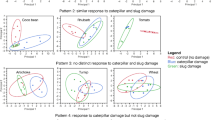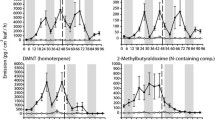Abstract
In response to insect herbivory, plants emit volatiles that are used by the herbivores’ natural enemies to locate their host or prey. Herbivore attack also enhances tea aroma. Herbivore-induced plant volatiles (HIPVs) vary both quantitatively and qualitatively with infestation duration and herbivore density. Thus, whether HIPVs can reliably communicate the identities of herbivores is of interest. Here, we studied the tea plant volatiles induced by the tea leafhopper (Empoasca vitis, a piercing–sucking insect), the tea geometrid (Ectropis oblique, a chewing insect), and methyl jasmonate (MeJA, a plant hormone). Geometrid feeding induced more complex volatile blends than did leafhopper infestation. The volatiles induced by both herbivores significantly increased in quality and quantity with time during the first 16 h of infestation, after which the profiles of induced volatile blends and the emission of induced compounds varied diurnally. (E)-β-Ocimene displayed a unique rhythm in which emission peaked at night. The amount of HIPVs significantly increased, while their profiles changed little, with herbivore density. Overall, the leafhoppers and geometrids induced significantly different volatiles from tea plants, while the HIPV profiles varied with a circadian rhythm and were similar at different herbivore densities. Our findings also suggest a new method of enhancing tea flavor using exogenously applied plant hormones, because the volatiles induced by leafhoppers and MeJA were similar in general composition.







Similar content being viewed by others
References
Adams RP (2001) Identification of essential oil components by gas chromatography/quadrupole mass spectroscopy. Allured, Carol Stream, USA
Arimura G, Huber DPW, Bohlmann J (2004) Forest tent caterpillars (Malacosoma disstria) induce local and systemic diurnal emissions of terpenoid volatiles in hybrid poplar (Populus trichocarpa × deltoides): cDNA cloning, functional characterization, and patterns of gene expression of (−)-germacrene D synthase, PtdTPS1. Plant J 37:603–616
Arimura G, Kost C, Boland W (2005) Herbivore-induced, indirect plant defences. Biochim Biophys Acta 1734:91–111
Arimura GI, Köpke S, Kunert M, Volpe V, David A, Brand P, Dabrowska P, Maffei ME, Boland W (2008) Effects of feeding Spodoptera littoralis on lima bean leaves: IV. Diurnal and nocturnal damage differentially initiate plant volatile emission. Plant Physiol 146:965–973
Brilli F, Ciccioli P, Frattoni M, Prestininzi M, Spanedda AF, Loreto F (2009) Constitutive and herbivore-induced monoterpenes emitted by Populus × euroamericana leaves are key volatiles that orient Chrysomela populi beetles. Plant, Cell Environ 32:542–552
Cai XM, Sun XL, Dong WX, Wang GC, Chen ZM (2012) Variability and stability of tea weevil-induced volatile emissions from tea plants with different weevil densities, photoperiod and infestation duration. Insect Sci 19:507–517
Cho JY, Mizutani M, Shimizu B, Kinoshita T, Ogura M, Tokoro K, Lin ML, Sakata K (2007) Chemical profiling and gene expression profiling during the manufacturing process of Taiwan Oolong Tea “Oriental Beauty”. Biosci Biotechnol Biochem 71:1476–1486
Cipollini D, Enright S, Traw MB, Bergelson J (2004) Salicylic acid inhibits jasmonic acid-induced resistance of Arabidopsis thaliana to Spodoptera exigua. Mol Ecol 13:1643–1653
De Boer JG, Posthumus MA, Dicke M (2004) Identification of volatiles that are used in discrimination between plants infested with prey or nonprey herbivores by a predatory mite. J Chem Ecol 30:2215–2230
De Moraes CM, Lewis WJ, Paré PW, Alborn HT, Tumlinson JH (1998) Herbivore-infested plants selectively attract parasitoids. Nature 393:570–573
Degenhardt DC, Lincoln DE (2006) Volatile emissions from an odorous plant in response to herbivory and methyl jasmonate exposure. J Chem Ecol 32:725–743
Diezel C, Von Dahl CC, Gaquerel E, Baldwin IT (2009) Different lepidopteran elicitors account for cross-talk in herbivory-induced phytohormone signaling. Plant Physiol 150:1576–1586
Dong F, Yang Z, Baldermann S, Sato Y, Asai T, Watanabe N (2011) Herbivore-induced volatiles from tea (Camellia sinensis) plants and their involvement in intraplant communication and changes in endogenous nonvolatile metabolites. J Agric Food Chem 59:13131–13135
Du Y, Poppy GM, Powell W, Pickett JA, Wadhams LJ, Woodcock CM (1998) Identification of semiochemicals released during aphid feeding that attract parasitoid Aphidius ervi. J Chem Ecol 24:1355–1368
Dudareva N, Negre F, Nagegowda DA, Orlova I (2006) Plant volatiles: recent advances and future perspective. Crit Rev Plant Sci 25:417–440
Erb M, Foresti N, Turlings TCJ (2010) A tritrophic signal that attracts parasitoids to host-damaged plants withstands disruption by non-host herbivores. BMC Plant Biol 10:247
Girling RD, Stewart-Jones A, Dherbecourt J, Stalely J, Wright DJ, Poppy GM (2011) Parasitoids select plants more heavily infested with their caterpillar hosts: a new approach to aid interpretation of plant headspace volatiles. Proc R Soc B 278:2646–2653
Gols R, Roosjen M, Dijkman H, Dicke M (2003) Induction of direct and indirect plant responses by jasmonic acid, low spider mite densities, or a combination of jasmonic acid treatment and spider mite infestation. J Chem Ecol 29:2651–2666
Gosset V, Harmel N, Gööbel C, Francis F, Haubruge E, Wathelet JP, Du Jardin P, Feussner I, Fauconnier ML (2009) Attacks by a piercing–sucking insect (Myzus persicae Sultzer) or a chewing insect (Leptinotarsa decemlineata Say) on potato plants (Solanum tuberosum L.) induce differential changes in volatile compound release and oxylipin synthesis. J Exp Bot 60:1231–1240
Gouinguené S, Alborn H, Turlings TCJ (2003) Induction of volatile emissions in maize by different larval instars of Spodoptera littoralis. J Chem Ecol 29:145–162
Hare JD (2011) Ecological role of volatiles produced by plants in response to damage by herbivorous insects. Annu Rev Entomol 56:161–180
Hare JD, Sun JJ (2011) Production of induced volatiles by Datura wrightii in response to damage by insects: effect of herbivore species and time. J Chem Ecol 37:751–764
Horiuchi JI, Arimura GI, Ozawa R, Shimoda T, Takabayashi J, Nishioka T (2003) A comparison of the responses of Tetranychus urticae (Acari: Tetranychidae) and Phytoseiulus persimilis (Acari: Phytoseiidae) to volatiles emitted from lima bean leaves with different levels of damage made by T. urticae or Spodoptera exigua (Lepidoptera: Noctuidae). Appl Entomol Zool 38:109–116
Ishiwari H, Suzuki T, Taro Maeda (2007) Essential compounds in herbivore-induced plant volatiles that attract the predatory mite Neoseiulus womersleyi. J Chem Ecol 33:1670–1681
Jönsson M, Anderson P (2007) Emission of oilseed rape volatiles after pollen beetle infestation; behavioural and electrophysiological responses in the parasitoid Phradis morionellus. Chemoecology 17:201–207
Kappers IF, Hoogerbrugge H, Bouwmeester HJ, Dicke M (2011) Variation in herbivory-induced volatiles among cucumber (Cucumis sativus L.) varieties has consequences for the attraction of carnivorous natural enemies. J Chem Ecol 37:150–160
Loughrin JH, Manukian A, Heath RR, Turlingst TCJ, Tumlinson JH (1994) Diurnal cycle of emission of induced volatile terpenoids by herbivore-injured cotton plants. Proc Natl Acad Sci USA 91:11836–11840
Maeda T, Liu Y, Ishiwari H, Shimoda T (2006) Conditioned olfactory responses of a predatory mite, Neoseiulus womersleyi, to volatiles from prey-infested plants. Entomol Exp Appl 121:167–175
Mumm R, Hilker M (2005) The significance of background odour for an egg parasitoid to detect plants with host eggs. Chem Senses 30:337–343
Mumm R, Tiemann T, Schulz S, Hilker M (2004) Analysis of volatiles from black pine (Pinus nigra): significance of wounding and egg deposition by a herbivorous sawfly. Phytochemistry 65:3221–3230
Pareja M, Moraes MCB, Clark SJ, Birkett MA, Powell W (2007) Response of the aphid parasitoid Aphidius funebris to volatiles from undamaged and aphid-infested Centaurea nigra. J Chem Ecol 33:695–710
Pieterse CMJ, Leon-Reyes A, Van der Ent S, Van Wees SCM (2009) Networking by small-molecule hormones in plant immunity. Nat Chem Biol 5:308–316
Ponzio C, Gols R, Pieterse CMJ, Dicke M (2013) Ecological and phytohormonal aspects of plant volatile emission in response to single and dual infestations with herbivores and phytopathogens. Funct Ecol 27:587–598
Rodriguez-Saona C, Crafts-Brandner SJ, Canas LA (2003) Volatile emissions triggered by multiple herbivore damage: beet armyworm and whitefly feeding on cotton plants. J Chem Ecol 29:2539–2550
Scascighini N, Mattiacci L, D’Alessandro M, Hern A, Rott AS, Dorn S (2005) New insights in analysing parasitoid attracting synomones: early volatile emission and use of stir bar sorptive extraction. Chemoecology 15:97–104
Scutareanu P, Bruin J, Posthumus MA, Drukker B (2003) Constitutive and herbivore-induced volatiles in pear, alder and hawthorn trees. Chemoecology 13:63–74
Shiojiri K, Ozawa R, Kugimiya S, Uefune M, van Wijk M, Sabelis MW, Takabayashi J (2010) Herbivore-specific, density-dependent induction of plant volatiles: honest or “cry wolf” signals? PLoS One 5:e12161
Sun XL, Wang GC, Cai XM, Jin S, Gao Y, Chen ZM (2010) The tea weevil, Myllocerinus aurolineatus, is attracted to volatiles induced by conspecifics. J Chem Ecol 36:388–395
Takabayashi J, Takahashi S, Dicke M, Posthumus MA (1995) Developmental stage of herbivore Pseudaletia separata affects production of herbivore-induced synomone by corn plants. J Chem Ecol 21:273–287
Turlings TCJ, Bernasconi M, Bertossa R (1998) The induction of volatiles in maize by three herbivore species with different feeding habits: possible consequences for their natural enemies. Bio Control 11:122–129
Zarate SI, Kempema LA, Walling LL (2007) Silverleaf whitefly induces salicylic acid defenses and suppresses effectual jasmonic acid defenses. Plant Physiol 143:866–875
Acknowledgments
We express our sincere thanks to Taro Maeda for donating DMNT standard. This work was supported by the National Natural Science Foundation of China (200930771449), and Science and Technology Department of Zhejiang Province (2009C32052).
Author information
Authors and Affiliations
Corresponding author
Additional information
Handling Editor: Michael Heethoff.
Rights and permissions
About this article
Cite this article
Cai, XM., Sun, XL., Dong, WX. et al. Herbivore species, infestation time, and herbivore density affect induced volatiles in tea plants. Chemoecology 24, 1–14 (2014). https://doi.org/10.1007/s00049-013-0141-2
Received:
Accepted:
Published:
Issue Date:
DOI: https://doi.org/10.1007/s00049-013-0141-2




